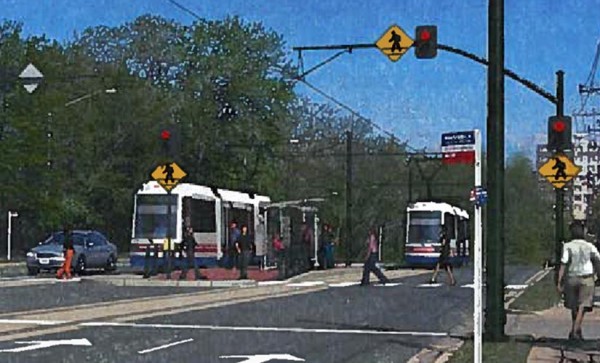The following letter to the editor was submitted by David DeCamp.
Sometimes when you fly into National Airport you get a perfect view of the buildings that comprise the Rosslyn-Ballston (R-B) corridor.
The tallest buildings are clustered around the metro stations and then taper off to garden apartments, single family houses and lots of trees. This is my “visual” for a turn-around story of epic proportions, and a template for why I am sure the streetcar system will benefit all of Arlington.
In the face of economic decline and even a shrinking population in the late 1960’s and 1970’s, visionaries like Arlington County Manager Burt Johnson boldly campaigned and cajoled naysayers to get the Blue and Orange Lines routed through Arlington with nine or ten stops inside the County. Then enlightened urban planning processes, starting with a document known as “R-B ’72,” articulated the tapered bulls-eye build-out around the future metro stations. The Blue Line opened in 1977 followed by the Orange Line in 1979. Arlington started to grow again. Because the urban planning and the rail-transit investments were coordinated early on, Arlington got more economic return out of Metro than any other jurisdiction.
How much more?
Consider this. I was fortunate enough to be part of a development team that built a mixed-use project on most of a city block near the Clarendon Metro Station. When we bought the parcel in the early 2000’s, it looked like a typical part of today’s Columbia Pike (a two-acre parking lot surrounding an old grocery structure). The annual real estate taxes were $100,000. Now that the ten-story Station Square project is built and occupied, it produces over $1,500,000 in real estate taxes each year. That’s an astounding 1,500% increase. Arlington collects this payment year after year and the occupants use almost no county services.
Take this one example and multiply it by about 200 other buildings in the transit-oriented development corridors that pay us a handsome annual dividend on our investment in transit and that is “The Arlington Miracle.”
As a result, Arlington’s businesses and residents enjoy the lowest tax rate in Northern Virginia and arguably the highest quality of life. We have more office space than downtown Dallas or Atlanta. Forty-nine percent of all tax receipts in Arlington come from businesses. Our businesses pay enough taxes to cover Arlington’s entire annual transfer payment for our high-achieving public school system. Believe me, when it costs around $18,000 a year for each student in the public schools, and most single family home-owners in Arlington pay less than $8,000 in real estate taxes, we need to encourage a robust and growing business tax base in Arlington.
The streetcar routes planned for Columbia Pike and continuing through Crystal City are using the same tried-and-true combination of coordinated urban planning in conjunction with appropriately sized transit investments. The transit and the enhanced development are inextricably linked. You can’t have one without the other. Scores of new buildings, comprising millions of square feet, have been planned through extensive community processes and scaled to suit the aspirations of the neighboring stake-holders. Buses alone do not have the required characteristics or capacity to move the projected growth.
And note: while the density increase is significant, the planned buildings for the Pike are not even half as large as those found in Rosslyn or Ballston. However, harkening back to The Arlington Miracle, early indications show us that we can expect the streetcar corridors to induce new transit-oriented buildings that yield a 500% increase in real estate taxes on re-developed sites. The Arlington streetcars will pay us back with a handsome and increasing return on investment.
Quoting retired Virginia state Senator Mary Margaret Whipple, from her April 2013 Washington Post Op-Ed, “Metrorail turned Arlington around, streetcars will keep it moving forward.”
David DeCamp is a real estate developer and sales agent. He is the immediate past-Chair of the Arlington Chamber of Commerce and serves on the board of the Columbia Pike Revitalization Organization (CPRO). David is a 2004 graduate of Leadership Arlington. According to DeCamp, he owns interests in commercial property in North Arlington but has no financial interest in any real estate in South Arlington. His views are his own.
To submit a letter to the editor, please email it to arlingtonnews@gmail.com. Letters to the editor may be edited for content and brevity.








